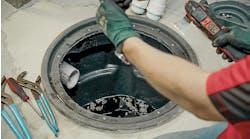Denver plumbing and heating contractor Dave Stroman collects old radiators. He has more than 100 of them. He has become well known for having what is needed and for knowing how to move them around. Why collect radiators?
"I guess it's like the dinosaurs," explained Stroman. "When they are all gone, there's no bringing them back."
Stroman specializes in boiler remodel jobs, especially in historical buildings. He found that often when he needed a radiator, there simply weren’t any. So he started keeping all of those that he removed to have on hand for other remodel jobs.
"It seems like people either love them or hate them," said Stroman. "Some just want them gone. They want to capture the floor space, and put in a 'modern' system. Others just cannot imagine heating with anything else. They heat so well."
Most of the radiators are free in exchange for removing them, either from jobs that Stroman is working on or from people who just want to be rid of them. His company moves them out of houses without any floor damage, including up and down stairs.
"The ability to move these heavy beasts is probably the key to our success," said Stroman. "I have the equipment to move just about any radiator, in one piece, out of a house and into my truck. A motorized stair climber dolly is the most important tool I have for this."
The radiators often need only a bit of reconditioning. If there are layers of old paint, he takes them to a company that does blasting and powder coating.
"They look absolutely stunning when finished," Stroman said.
Other than the aesthetics, "a radiator from a water system is a sure bet to be a good radiator," said Stroman. Radiators from steam systems are less certain — many steam radiators will not pass an air test, and some are rusted out.
Most of Stroman's radiators are put into remodels or additions because cast iron radiators are already in use or because radiators fit the style of the house. He also uses them to replace radiators that are leaking or have frozen.
"Some people who have lived with them before want them because they put out such nice heat," Stroman explained. "There is something about the heat emitted from these beauties. When we start up a system in a cold house, and you stand next to one of these big massive radiators, it is hard to explain the feeling you get as the cast iron slowly warms up. They invite you to get next to them or sit on them. It changes the whole atmosphere of the space.
"Occasionally I have brought them in as part of a brand new system," he added. "But they really have to fit the character of the house. They aren't something for a new-style house."
Why would a person want a used radiator rather than radiant floor heating?
"Really, the only thing better than a radiator is a radiant floor," Stroman said. "But in these old houses, it is not always possible to heat with radiant floors because of bare brick walls and no insulation. I have made it work, but it is a leap of faith. Computerized heat loss programs will probably tell you that the floors alone will not be enough to heat the space. But put a big radiator under one of those single pane windows, and no problem!"
Stroman has made a sub-specialty with massive radiators that were long ago assembled on site, usually in blocks of four or five sections — whatever was enough to get the required heat output — and cannot be moved in one piece. The sections of these big radiators are interconnected using one of two methods. One does not require any special tools, so it is easy to replace sections, and to remove or install the whole radiator.
The other method of installing the sections required special tools that could be inserted down inside the sections. This was an easy task when the radiators were new and the tools were available, but virtually impossible after decades of rust build up and scarcity of the tools.
"It made me sick to see the number of radiators that were scraped just because of one or two bad sections," Stroman said.
After a lot of searching, Stroman found a contractor friend who had a set of the tools and told stories of how his father repaired radiators. He took some photos and headed to a machine shop. After several prototypes he now has a set of tools to disassemble and reassemble the radiator sections. But it's still far from easy.
"We wrestle the radiator out onto the street and wedge it under the bumper of my truck," said Stroman. "Then we slide the radiator wrench inside to engage the nipple of the section that needs to be removed. Then, using 4-ft. long pipe wrenches with 8-ft. long cheaters, we crank on the nipples until they break loose. It does not work 100% of the time. Sometimes the little tabs inside break off."
Stroman finds that he has a nice "niche" business.
"Very few companies are willing or able to work on or move these big old radiators," he explained. "I have been hired to simply disconnect them, move them to the sandblaster and powder coater, then move them back in and reconnect. Of course, we do all of this without any damage to the nice hardwood floors."
Carol Fey is a technical trainer and the author of books and a DVD on electricity, troubleshooting and controls. You can e-mail her at [email protected] or visit her website at www.carolfey.com. You can also visit her blog at: http://carolfey.blogspot.com.

